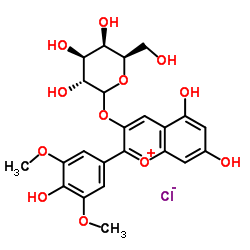Malvidin-3-O-galactoside chloride

Malvidin-3-O-galactoside chloride structure
|
Common Name | Malvidin-3-O-galactoside chloride | ||
|---|---|---|---|---|
| CAS Number | 30113-37-2 | Molecular Weight | 528.890 | |
| Density | N/A | Boiling Point | N/A | |
| Molecular Formula | C23H25ClO12 | Melting Point | N/A | |
| MSDS | Chinese USA | Flash Point | N/A | |
Use of Malvidin-3-O-galactoside chlorideMalvidin-3-galactoside chloride, an anthocyanin monomer, induces hepatocellular carcinoma (HCC) cells cycle arrest and apoptosis. Malvidin-3-galactoside chloride inhibits the production and accumulation of ROS. Malvidin-3-galactoside chloride has anti-tumor function[1]. |
| Name | malvidin-3-galactoside chloride |
|---|---|
| Synonym | More Synonyms |
| Description | Malvidin-3-galactoside chloride, an anthocyanin monomer, induces hepatocellular carcinoma (HCC) cells cycle arrest and apoptosis. Malvidin-3-galactoside chloride inhibits the production and accumulation of ROS. Malvidin-3-galactoside chloride has anti-tumor function[1]. |
|---|---|
| Related Catalog | |
| In Vitro | Malvidin-3-galactoside chloride (50, 100, 200 μg/mL; for 24, 48, 72 h) displays obvious cytotoxicity on Huh-7 cells and has no significant effect with 50 and 100 μg/mL for 48 h. Malvidin-3-galactoside chloride has a notable cytotoxic effect against Huh-7 cells at 72 h[1]. Malvidin-3-galactoside chloride (50-200 μg/mL) arrests the cells in the S phase, accompanied by the cells in the G1 phase decreased, and the cells in the S phase increased[1]. Malvidin-3-galactoside chloride (50-200 μg/mL; for 72 h) induces cell apoptosis in Huh-7 cells[1]. Malvidin-3-galactoside chloride (50-200 μg/mL; for 72 h) markedly increased the levels of caspase-3, cleaved-caspase-3 and cleaved-PARP in a dose-dependent manner[1]. Malvidin-3-galactoside chloride (50-200 μg/mL; for 12 h) inhibits the production and accumulation of ROS[1]. Malvidin-3-galactoside chloride (50-200 μg/mL; for 12 h) dramatically reduces the level of phosphorylation ERK (p-ERK) in a dose-dependent manner. Malvidin-3-galactoside chloride with 200 μg/mL markedly increases the phosphorylation level of p38 and JNK (p-p38 and p-JNK)[1]. Malvidin-3-galactoside chloride (50-200 μg/mL; for 12 h) inhibits the migration and invasion in Huh-7 cells[1]. |
| References |
| Molecular Formula | C23H25ClO12 |
|---|---|
| Molecular Weight | 528.890 |
| Exact Mass | 528.103455 |
| PSA | 191.67000 |
| Storage condition | 2-8°C |
| Personal Protective Equipment | Eyeshields;Gloves;type N95 (US);type P1 (EN143) respirator filter |
|---|---|
| RIDADR | NONH for all modes of transport |
| WGK Germany | 3 |
|
Bog bilberry (Vaccinium uliginosum L.) extract reduces cultured Hep-G2, Caco-2, and 3T3-L1 cell viability, affects cell cycle progression, and has variable effects on membrane permeability.
J. Food Sci. 75(3) , H103-7, (2010) Bog bilberry (Vaccinium uliginosum L.) is a blue-pigmented edible berry related to bilberry (Vaccinium myrtillus L.) and the common blueberry (Vaccinium corymbosum). The objective of this study was to... |
|
|
Phenolic compounds and bioactivities of pigmented rice.
Crit. Rev. Food Sci. Nutr 53(3) , 296-306, (2013) The pigmented rice has been consumed in China, Japan, and Korea for a long time. It has been used for strengthening kidney function, treating anemia, promoting blood circulation, removing blood stasis... |
|
|
Direct effects of Vaccinium myrtillus L. fruit extracts on rat heart mitochondrial functions.
Phytother Res. 27(4) , 499-506, (2013) In this study, the direct influence of bilberry (Vaccinium myrtillus) fruit extracts (aqueous and ethanolic) rich in anthocyanins on the oxidative phosphorylation of isolated rat heart mitochondria wa... |
| PRIMULINE FOR MICROSCOPY |
| PRIMULIN |
| 5,7-Dihydroxy-2-(4-hydroxy-3,5-dimethoxyphenyl)-3-chromeniumyl D-galactopyranoside chloride |
| PRIMULIN CHLORIDE |
| EINECS 250-055-1 |
| D-Galactopyranoside, 5,7-dihydroxy-2-(4-hydroxy-3,5-dimethoxyphenyl)-1-benzopyrylium-3-yl, chloride (1:1) |
| MALVIDIN-3-O-GALACTOSIDE CHLORIDE |
| malvidin 3-galactoside |

